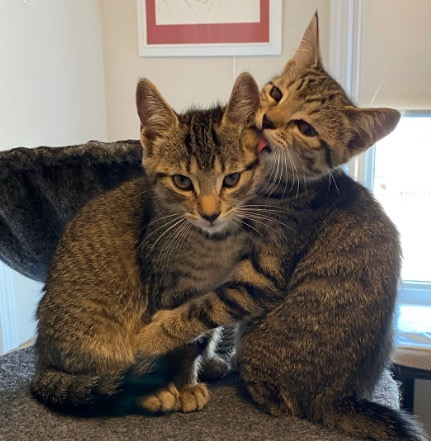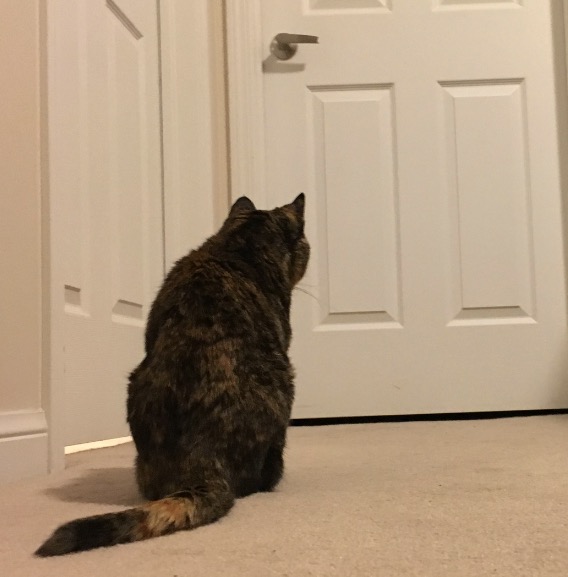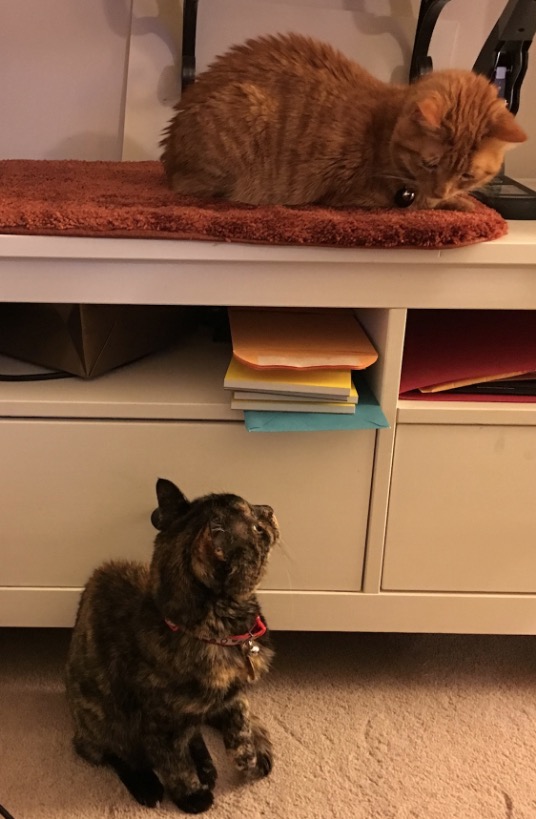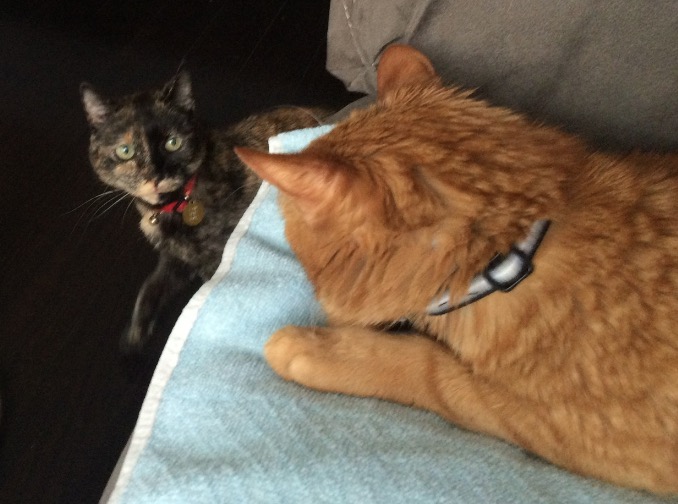Day 73
We knew it was coming, but today it became real: part of our litter of kittens will move to an Adoption Centre the weekend of 25 September. There is a large cat condo available and we have decided to use it. Two kittens will remain with the mother cat, so that she does not develop ’empty-nest’ syndrome right away. Ultimately these kittens will come up for adoption when mom gets spayed. Spaying will change her life in many ways and she will not miss the kittens as much, as she recuperates from surgery and the hormone flow in her blood calms down. This sets her up for a new future that might play out as an indoor domesticated cat, or as an indoor/outdoor cat in a protected colony or private property. There are still many open endings about that right now…

You can go and meet our kittens at the Pet Smart store at Oakville Place in Oakville. It is a nice newly-built spacious store with a 4 star accommodation for cats that are ready for adoption. We will enjoy these coming 5 days with them to the max. They currently have a large playing field in the room we opened up for them. They got plenty of love, good food and interaction to build a good foundation for their future. All we can do now is hope that they will not have to spend too much time in the store.
We struggled with our decision, I have to be honest. It is a bittersweet reality check, but we also know there is never a good moment for it. However, these kittens need an expansion of their world. They need to know that we are not the only two humans that can be trusted and offer fun and companionship. They are still pretty timid with strangers, but will do well to transition into fuzzy love balls with the right new owners. Ninth Life works with an army of devoted volunteers, who interact daily with the animals in the Adoption Centre and they will also introduce them to other cats that live there temporarily.
Play and food are the magic words
I think kittens at this age (they will be 11 weeks when they make the move) can be compared to 4 year old humans.
They are curious but also a bit afraid about new situations and environment. My experience is that play and food are the magic words to win them over. Kittens easily loose themselves in play and it releases feel-good chemicals in their blood. Food comes naturally. Just make sure to find out what they were fed before you adopted them and gradually switched to your own preferred brands. This will prevent diarrhea or constipation. Make sure to have plenty of fresh water – we have 2 ‘auto-fill’ water containers so that there is never a shortage. We don’t fill them up completely, so that it does not become stale.
All of our kittens have their own favourite toy: Stick toys with fluffy stuff at the end. You can have them racing around to the point of panting without much trouble. Some go for the fluffy bits, others get triggered by the stick part. They also love tinkling balls. Their absolute favourite toy (see previous post) is the three way play tunnel. And a good tree with some high and enclosed hiding places is also appreciated.

With a bit of commitment, you will quickly become their surrogate mother and safe spot. Add to that a cozy place to sleep, close to their new human, and all will be well. Don’t take them IN your bed: give them their own space and keep putting them there until they get the message. Or make several spots available and go with the kitten’s natural preference. Until a certain level of comfort is reached, though, don’t take it personally when a kitten retreats from you and hisses and does not wish to engage. Remember yourself at that age (4) when you went for a sleep-over with people you did not really know that well. I bet there were tears and some anxiety the moment your parents ‘left the building’…! It is only natural and it does not mean that the kitten rejects you.
Allergies
There are many stories of kittens returned after adoption because someone in the family turns out to have an allergy for cats. I would hate to see that happen with our kittens. I know for a fact that Ninth Life Adoption centers welcome people who want to come and cuddle with the available cats. It’s a great way to see if a particular pair tugs at your heartstrings. And it will quickly tell you if there is an allergy issue. It is pretty traumatising for cats to be returned, after just being introduced to a new environment. I am also a strong believer in selecting a cat that I am drawn to, more than going by exterior or an online description. You will be the best cat parent when you feel an instant connection with the kitten or adult cat.
Adopting in pairs

There are many opinions about adopting kittens in pairs or take the on solo. But when they are bonded to a sibling, they will really pine for their companion. There is another reason to prefer adopting young kittens in pairs, or have at least one other cat at home that they can befriend. If a kitten does not interact with another cat, how can they see what cat behaviour is all about? We have seen the ‘copying’ effect in our feline family time and time again. One kitten discovers something new. Ventures out to explore and finds it interesting. In a matter of minutes the other cats notice it, and will then also go and explore. Kittens that see mom poop on the litter box, study her intently, then go play in the litter box to explore and ultimately get litter box trained without any human interaction. Eating solid foods followed the same pattern. There is great interest in the kitten that first starts to eat. The others first start touching the food with their paws, then take it in their mouth for taste and in no time they are all eating.
Introducing cats to each other
If you adopt a single kitten and have a resident cat, it will take a lot of time and effort to introduce the two to each other. That is where a safe Basecamp room for the kitten comes in. That is where it can become confident in its new surroundings, with your active help and interaction. Never just confront the two: it hardly ever makes for a good start in their relationship. Give the kitten its own trusted room and once it is used to you and the new house, allow the two cats to meet by sniffing under the door first.

Then seeing each other through a ‘baby gate’ so that there can be no unwanted harsh confrontations. Then see if both cats will eat alongside the same (closed) door. If that happens it means they are both aware of each other but willing to be vulnerable and eat in each other’s company. The next step is having the door ajar and gradually opening it up. You know your resident cat the best, so go with his or her reactions to determine when it is time to meet without a barrier in between.


Room swapping
Some people believe in room and object swapping: put something in both cats’ preferred space that comes from the other cat so they can sniff and get to know the scent. Then get your resident cat locked in one room, and let the new cat into its living space. The next time, turn it around. Lock the new cat in a safe area and let the resident cat have a sniff in its basecamp. In the final analysis, don’t tell yourself that the two cats absolutely must become best buddies. Go for a scenario where both cats tolerate each other without aggression and give time and patience to the process. You may end up with two cats sharing the same bed – which is wonderful. Or two independent creatures that respect each other and enjoy your company and are able to eat in the same room. Which is also wonderful!